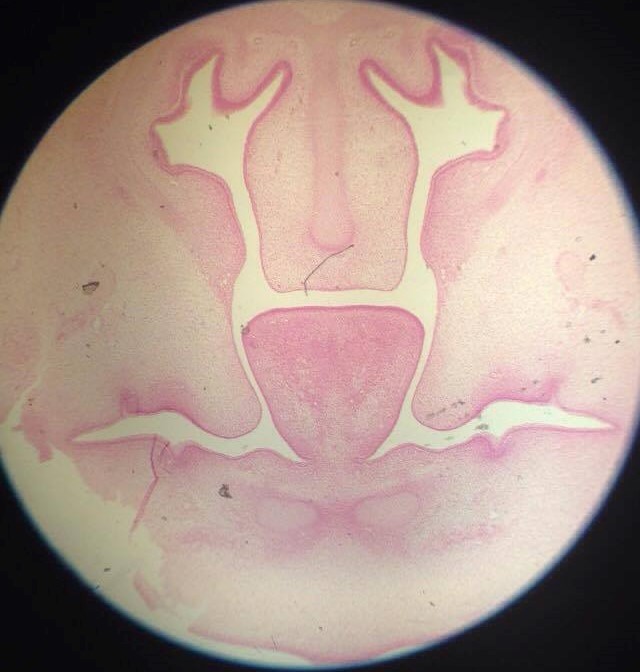Secondary Palate Development on:
[Wikipedia]
[Google]
[Amazon]
The development of the
 The formation of the vertical palatal shelves occurs during week 7 of embryological development, on the maxillary processes of the head of the embryo, lateral to the developing tongue.
The formation of the vertical palatal shelves occurs during week 7 of embryological development, on the maxillary processes of the head of the embryo, lateral to the developing tongue.
Craniofacial, Cleft Palate
{{Embryology of head and neck Embryology
secondary palate
The secondary palate is an anatomical structure that divides the nasal cavity from the oral cavity in many vertebrates.
In human embryology, it refers to that portion of the hard palate that is formed by the growth of the two palatine shelves med ...
commences in the sixth week of human embryonic development
Human embryonic development or human embryogenesis is the development and formation of the human embryo. It is characterised by the processes of cell division and cellular differentiation of the embryo that occurs during the early stages of d ...
. It is characterised by the formation of two palatal shelves on the maxillary prominence
Continuous with the dorsal end of the Pharyngeal arch#First arch, first pharyngeal arch, and growing forward from its cephalic border, is a triangular process, the maxillary prominence (or maxillary process), the Anatomical terms of location#Dors ...
s, the elevation of these shelves to a horizontal position, and then a process of palatal fusion between the horizontal shelves. The shelves will also fuse anteriorly upon the primary palate
Around the 5th week, the intermaxillary segment arises as a result of fusion of the two medial nasal processes and the frontonasal process within the embryo. The intermaxillary segment gives rise to the primary palate. The primary palate will form ...
, with the incisive foramen
In the human mouth, the incisive foramen (also known as: "''anterior palatine foramen''", or "''nasopalatine foramen''") is the opening of the incisive canals on the hard palate immediately behind the incisor teeth. It gives passage to blood ves ...
being the landmark between the primary palate and secondary palate. This forms what is known as the roof of the mouth, or the hard palate
The hard palate is a thin horizontal bony plate made up of two bones of the facial skeleton, located in the roof of the mouth. The bones are the palatine process of the maxilla and the horizontal plate of palatine bone. The hard palate spans ...
.
The formation and development of the secondary palate occurs through signalling molecules SHH, BMP-2
The BMP-2 (''Boyevaya Mashina Pekhoty'', , literally "combat machine/vehicle f theinfantry") is an amphibious infantry fighting vehicle introduced in the 1980s in the Soviet Union, following on from the BMP-1 of the 1960s.
Development his ...
, FGF-8, among others.
Failure of the secondary palate to develop correctly may result in a cleft palate
A cleft lip contains an opening in the upper lip that may extend into the nose. The opening may be on one side, both sides, or in the middle. A cleft palate occurs when the palate (the roof of the mouth) contains an opening into the nose. The ...
disorder.
Formation of palatal shelves
 The formation of the vertical palatal shelves occurs during week 7 of embryological development, on the maxillary processes of the head of the embryo, lateral to the developing tongue.
The formation of the vertical palatal shelves occurs during week 7 of embryological development, on the maxillary processes of the head of the embryo, lateral to the developing tongue.
Palatal shelf elevation
The elevation of the palatal shelves from a vertical position to a horizontal one occurs during week 8 of embryological development. The direct cause of this movement is unknown, but a number of possibilities have been identified as follows: * Muscular contraction; *Hydrostatic
Hydrostatics is the branch of fluid mechanics that studies fluids at hydrostatic equilibrium and "the pressure in a fluid or exerted by a fluid on an immersed body". The word "hydrostatics" is sometimes used to refer specifically to water and o ...
forces exerted by glycosaminoglycan
Glycosaminoglycans (GAGs) or mucopolysaccharides are long, linear polysaccharides consisting of repeating disaccharide units (i.e. two-sugar units). The repeating two-sugar unit consists of a uronic sugar and an amino sugar, except in the case o ...
s and hyaluronan
Hyaluronic acid (; abbreviated HA; conjugate acid, conjugate base hyaluronate), also called hyaluronan, is an anion#Anions and cations, anionic, Sulfation, nonsulfated glycosaminoglycan distributed widely throughout connective tissue, connective ...
;
* Mesenchymal reorganisation;
* Mesenchyme
Mesenchyme () is a type of loosely organized animal embryonic connective tissue of undifferentiated cells that give rise to most tissues, such as skin, blood, or bone. The interactions between mesenchyme and epithelium help to form nearly ever ...
cell contraction;
* Epithelial reorganisation;
* Movement of the developing tongue.
Suggested mechanisms for palatal fusion
Fusion between the two palatal shelves occurs during week 9 of embryonic development. In this time, the elevated palatal shelves join together to form one continuous structure, with the medial edge epithelium (the shelf surfaces which are closest to each other) disappearing. The specific mechanism by which the medial edge epithelium disappears has been differed over by academics. The three most distinguished theories related to the explanation of palatal fusion are as follows: * Epithelialapoptosis
Apoptosis (from ) is a form of programmed cell death that occurs in multicellular organisms and in some eukaryotic, single-celled microorganisms such as yeast. Biochemistry, Biochemical events lead to characteristic cell changes (Morphology (biol ...
;
* Epithelial-to-mesenchymal transformation;
* Epithelial cell migration
Cell migration is a central process in the development and maintenance of multicellular organisms. Tissue formation during embryogenesis, embryonic development, wound healing and immune system, immune responses all require the orchestrated movemen ...
.
See also
*References
*External links
Craniofacial, Cleft Palate
{{Embryology of head and neck Embryology